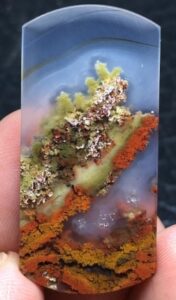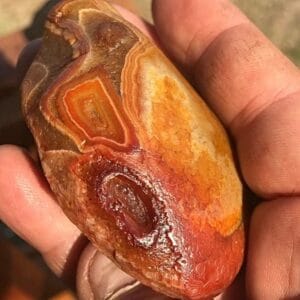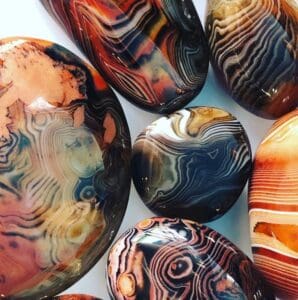Agate is used to describe the banded form of Chalcedony but the term also covers translucent varieties like Dendritic, Moss, Fire, and Iris Agate. Over the years lapidary artists have used all varieties of agates to carve beads, cameos, decorative objects, and cabochons.
Agate crystals are microcrystalline-quartz mineraloids with a lustrous display of bi and multi-colored banding. This gemstone is highly marketable and popular among gem enthusiasts.
If you’re a rockhound then agate is found in every state with each state having a unique variety.
How to Identify Agate Through Testing
There are various ways to identify rocks, minerals, crystals, and gemstones, but we will be using a method I learned while attending the Gemological Institute of America. If you’ve learned a unique way to identify gems, then feel free to share it with us.
Let’s take a deeper look into how to identify agate like a pro.

Visual Inspection
The visual inspection starts with what form of agate you have. The questions below are relatively easy to answer, but each type will have its own process for identifying them. The biggest question you’ll need to answer is which variety of agate do you have and there are quite a few varieties. Over time you’ll have a knowledge bank that will allow you to name all of the varieties accurately. In the meantime, get good at identifying agate as a whole and work on the varieties later.

Is it a cabochon? If you’re dealing with a cabochon, it should have a high polish with very little pitting on the surface. Agates have a more fibrous texture than something like Jasper, which is more granular. Agates are known for their translucency and patterns.
If you need help valuing and pricing agate then use my free guide.
Is it faceted? If you have a faceted piece of agate, it should be opaque and this is highly uncommon. Try shining a light through it; you shouldn’t see transparency in the stone.

Is it a specimen? Agate is found in different forms, and you’ll get better at identifying these forms by looking at and inspecting this mineral over time. Here’s a list of characteristics agate displays when it’s a specimen.
- Various shapes and patterns.
- An extensive range of colors is possible.
- There’s often a distinct visible pattern that stands out.
- Size ranges from small to medium finds.

Is it tumbled? Very common to find tumbled agate. It comes in a wide variety of colors and color combinations. Tumbled agate will be opaque, polished, and smooth.
Physical Properties of Agate
Let’s take a look at the physical properties of agate. Knowing what to look for will help you more easily identify what you’re looking at.
Color: Pink, Yellow, White, Red, Purple, Grey, Black, Blue, Green, Brown, Orange, Multi-Color, Bi-Color
Clarity / Transparency: Translucent, Semitransparent
Luster: Vitreous, Greasy
Cleavage: None
Fracture: Conchoidal, Granular
The Streak Test
This is a destructive test, so you need to ensure that you’re allowed to damage the specimen or stone if you choose to use this method. Once you’ve developed robust knowledge in identifying rocks and minerals, you won’t be using destructive tests.
A mineral streak test involves scraping the stone against a harder surface to see what color remains. Agate produces a white streak.
Tumbled specimens are tested by scraping a specimen across a piece of ungalvanized porcelain, typically known as a streak plate.
The only minerals that will produce or leave a streak have a hardness level of less than 7. This is because a porcelain streak plate has a hardness of 7 on the Mohs scale, meaning anything harder than the plate will scratch the plate instead of leaving a streak.
Magnet Test
Some Agates are slightly magnetic, so they may or may not respond to common magnets. However, there are exceptions to the magnet test.
For instance, Xuanhua Agate varieties contain intense red and yellow colors. Since iron oxide minerals are more likely to be present, which is where the hues come from. When this occurs, the chemical composition of Agate changes, making the Agate weakly attracted to magnets.
Hardness Test
I don’t recommend actively testing the hardness of a stone because it’s destructive in nature and doesn’t really provide a definite answer to what type of stone it is. That said, Agate has a hardness of 6.5 to 7 on the Mohs hardness scale.
Refractive Index Test
Determining the refractive index, or RI as it’s referred to by gemologists, for Agate is fairly straightforward, but you’ll need a specific piece of test equipment and the RI fluid to go with it. Before you place the stone on the refractometer, you want to make sure you have a flat, somewhat polished surface to take a reading.
Agate’s Refractive Index: 1.535 – 1.539
Each gemstone has its own RI, so discovering a sample’s RI can help you figure out what sort of stone it actually is.
Step 1 – Place a small bead of RI fluid on the metal surface of the refractometer near the back of the crystal hemicylinder (the window on which the stone will sit).
Step 2 – Place the stone facet face down on the fluid dot and slide it toward the middle of the hemicylinder crystal using your fingers.
Step 3 – Look through the viewer lens without magnification. Continue looking until you see the outline of a bubble, then look at the bottom of this bubble. Take the reading from there, rounding the decimal to the nearest hundredth.
From time to time, you’ll run into the issue of not having a flat surface to work with. In this instance, you’ll need to leave the top of the refractometer open and hold the rounded stone with your hand. Hopefully, you’ll be able to pull a reading off of the gauge.
Birefringence Test
You won’t be using this test for Agate because it has such a weak birefringence. But I wanted to include this test just in case you were considering it in your process
Consider testing the birefringence, as well. Birefringence is related to RI. While doing the birefringence test, you will turn the gemstone on the refractometer six times throughout the observation period and note the changes.
Perform a standard RI test. Instead of keeping the stone still, gradually turn it 180 degrees, making each separate turn about 30 degrees. At each 30-degree mark, take a new RI reading.
Subtract the lowest reading from the highest to find the stone’s birefringence. Round it to the nearest thousandth.
Birefringence: δ = 0.004
Single or Double Refraction
Agate is doubly refracting, so it will produce a bi-refraction.
For this test to be accurate and beneficial, the stone needs to be transparent in nature. If the light won’t pass through the stone, then there is no way to test for single or double refraction.
Check for single or double refraction. Use this test on translucent and transparent stones. You can determine whether the stone is only singly refractive (SR) or doubly refractive (DR) to help identify it. Some stones can also be classified as aggregate (AGG).
Turn on the light of a polariscope and place the stone face down on the lower glass lens (polarizer). Look through the top lens (analyzer), turning the top lens until the area around the stone looks darkest. This is your starting point.
Turn the analyzer 360 degrees and watch how the light around the stone changes.
If the stone appears dark and stays dark, it is likely an SR. If the stone starts out light and stays light, it is likely AGG. If the lightness or darkness of the stone changes, it is likely DR.
Checking The Diaphaneity
Diaphaneity refers to the mineral’s ability to transmit light. For instance, some minerals are transparent or translucent. When they’re thick, a small amount of distortion might occur, but light will pass through them relatively freely.
Agate is translucent. However, its translucency depends on the form it has taken. While occasionally Agate is opaque, it is sometimes completely transparent.
Finding The Specific Gravity
Every stone has its unique specific gravity, which helps us identify them. Specific gravity is one of the best properties to measure when identifying mineral specimens. Most minerals have a narrow range of specific gravity, so getting an accurate measurement can go a long way toward identification.
Specific gravity is a unitless number describing how heavy a mineral is compared to equal volumes of water. For example, if a mineral is three times as dense as water, it’ll have a specific gravity of three. This is useful because while two minerals might be the same size, they’ll each have a different specific gravity.
The larger the sample, the more precise the readings tend to be. Remember that this technique can only be used for single mineral or crystal masses. It will not work for minerals embedded in host rocks.
Agate’s Specific Gravity: 2.550 – 2.700
As helpful as specific gravity is for identifying minerals, amateurs are usually constrained by the lack of necessary tools for the job. However, one way to work around this is to hold the specimen and note how heavy or heft it feels compared to what you might expect a specimen of that size to weigh.
If you want to determine the specific gravity of your stone like a pro, you’ll need to invest in a higher-end scale. This is the one gemologists use OHAUS Density Determination Kit.
Identifying Rocks and Minerals Like a Pro
Hopefully, you feel confident in your practice to identify a piece of Agate after reading and applying this guide. You’ll be using the visual part of this guide the most, and you’ll improve as you interact with more gemstones. Before you know it, you’ll be identifying stones like a gemologist.
If you run into any issues or you get confused, then feel free to reach out, and I’ll do my best to assist you in the identification process.
- Identify Enstatite - March 12, 2024
- Identify Cerussite - March 3, 2024
- Identify Bytownite - February 18, 2024
